
Pimelea, commonly known as rice flowers, is a genus of plants belonging to the family Thymelaeaceae. There are about 150 species, including 110 in Australia and thirty six in New Zealand.
Hebe traversii and the synonym Veronica traversii are unresolved names for an ornamental plant of the family Plantaginaceae. It is a native plant endemic to New Zealand. The specific epithet traversii is in honor of naturalist Henry H. Travers (1844-1928), son of William Thomas Locke Travers.

Eremophila longifolia, known by a range of common names including berrigan, is a flowering plant in the figwort family, Scrophulariaceae and is endemic to Australia. It is a shrub or small tree with weeping branches, long, narrow leaves and brick-red or pink flowers and is found in all Australian mainland states and the Northern Territory.
Henry Hammersley Travers was a New Zealand naturalist, professional collector and taxidermist. He was the son of the politician William Travers.

Lomandra longifolia, commonly known as spiny-head mat-rush, spiky-headed mat-rush or basket grass, is a perennial, rhizomatous herb found throughout eastern Australia. The leaves are 40 cm to 80 cm long, and generally have a leaf of about 8 mm to 12 mm wide. It grows in a variety of soil types and is frost, heat and drought tolerant. Labillardiere described Lomandra longifolia from a specimen collected in Tasmania.
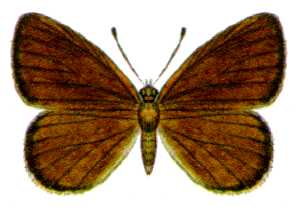
Candalides heathi, the rayed blue, is a species of butterfly of the family Lycaenidae. It is found in southern Australia, including South Australia, New South Wales and Victoria.
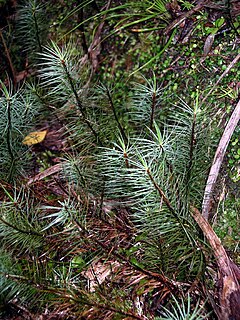
Dawsonia is a genus of acrocarpous mosses. Dawsonia, along with other members of the order Polytrichales, are taller than most mosses and have thicker leaves. Their sporophytes have conducting systems analogous to those of vascular plants. Dawsonia superba is found in New Zealand, Australia and New Guinea. Dawsonia longifolia is found in the Philippines, Indonesia, Malaysia, and Australia. Dawsonia superba and Dawsonia longifolia may be the same species.
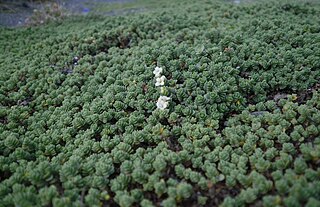
Pimelea urvilleana subsp. urvilleana, commonly known as pinatoro, is a ground spreading shrub native to New Zealand.
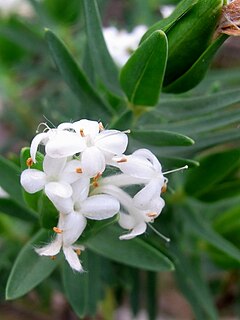
Pimelea congesta is a flowering plant in the Thymelaeaceae family. The specific epithet refers to the congested inflorescence.
Pimelea villosa, also known as Pimelea arenaria, is a species of shrub in the family Thymelaeaceae. It is endemic to New Zealand. Its conservation status puts it at risk and declining, as determined by the New Zealand Threat Classification System (NZTCS).
Pimelea gnidia is a species of small shrub in the family Thymelaeaceae. It is endemic to New Zealand. According to the New Zealand Threat Classification System (NZTCS), it is not threatened as of 2012.
Pimelea virgata is a species of small shrub, of the family Thymelaeaceae. It is native to Australia.
Pimelea prostrata, also known as Strathmore weed, is a species of small shrub, of the family Thymelaeaceae. It is endemic to New Zealand.
Pimelea lyallii, commonly known as the Southern sand daphne, is a species of small shrub, of the family Thymelaeaceae.
Pimelea traversii is a species of shrub in the family Thymelaeaceae. It is native to New Zealand. The specific epithet traversii is in honor of naturalist Henry H. Travers (1844-1928), son of William Thomas Locke Travers.

Pimelea actea is a small coastal plant native to New Zealand. It was named and described by Colin J. Burrows in 2008 as part of a revision of the New Zealand Pimelea, a project he had begun as a Master's thesis in the 1950s and continued in his retirement. Burrows described the species, which for some time had been referred to as Pimelea "Turakina", from a specimen collected in 1968, now in the Auckland Museum. Its species name, actea, means "coastal".
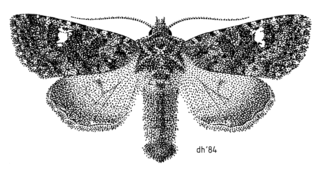
Meterana meyricci is a species of moth in the Noctuidae family. It was described and named by George Hampson in 1911 as Miselia meyricci. It is endemic to New Zealand and has been collected in and around Otago. The larvae of this species feed on Pimelea species, including Pimelea poppelwellii. Adults tend to found on the wing during the months of January to March.
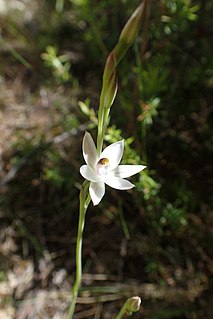
Thelymitra longifolia, commonly called the white sun orchid, common sun orchid or maikuku, is a species of orchid in the family Orchidaceae that is endemic to New Zealand. It was the first of a large number of similar species to be described and is therefore the type species. It has a single grass-like leaf and up to five white flowers
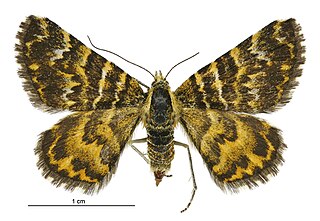
Notoreas elegans is a species of moth in the family Geometridae. It is endemic to New Zealand. This species has a wide distribution in New Zealand and is therefore regarded as not being in need of conservation.
Nina Lucy Mary Jones was an artist and botanical illustrator from Nelson, New Zealand.












